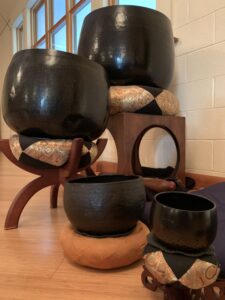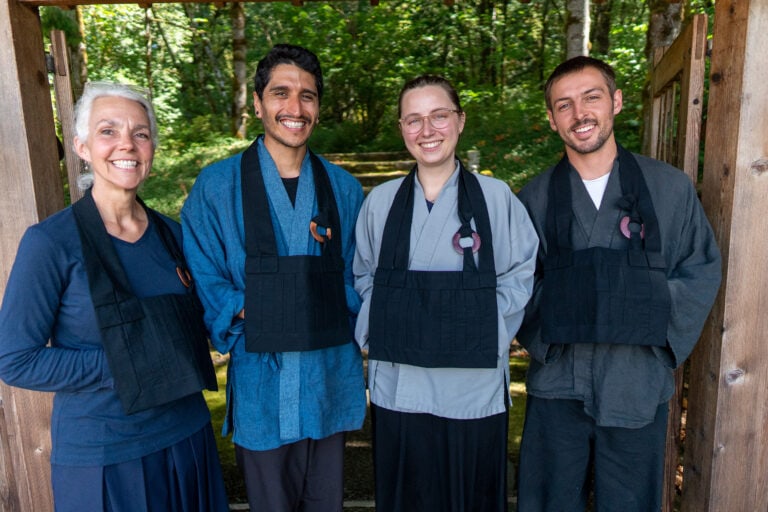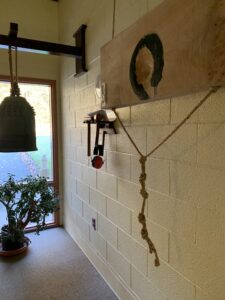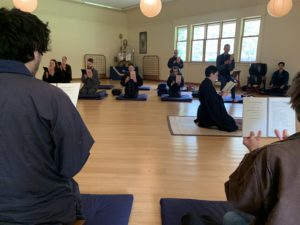At exactly 4:20 by the handy ticking analog clock, I strike the han with the opening call. It’s still dark out, and the buildings and passages are all illuminated with quiet light. A wall-mounted paper lantern sheds a wan light on the coded han instructions which, after many, many missteps, now feels well-rehearsed.
I take the remarkably long 20 seconds before the next strike to breathe, alerting the heretofore unwitting mosquitoes who winter over here to my whereabouts.
After the starting call, there are three runs of the han. Although we eschew preference, I especially like the pattern of the second run with the perky “bam!bam!” at the 5:20 mark. In addition to breathing, I engage in various stretches and tiny games at the han. I use my unruly left hand for single strikes, reserving my trusty right for the long (30 seconds!) runs.
Once the sequence is complete, I replace the striker and the ear protection in their respective positions. The mosquitoes return to their rest. I close the previously open doors to the Guest Area and the Residence, doff the lavender slippers by the others outside the zendo door and breathe once more before I enter the zendo to settle into the Timekeeper’s seat. Here my cushion and I are ensconced in a nest of bells and strikers. As close to 4:30 as possible, Shuso performs kenton rounds to start the day. As he passes my seat, I greet his feet with a silent, “Good morning, Gensei.” Once he’s made his circuit of the zendo and resettled, I invite the medium bell with three strikes to signal the beginning of zazen.
This sweet sound resonates through the hall and out onto zoom. I trust that, even in the dark of a cool fall morning, it fills all listeners with the resolve to breathe deeply and to secure mind in the body for zazen. Often, Chozen encourages us to listen to the bell entirely, until we can no longer hear it, an invitation into this very place and time, the only time there is.

For this Timekeeper, though, there is some conflict between the lavish focused abandon of zazen and the need to keep the trains running on time. Tom has suggested that I use the clock as a means of practice. For instance, how many breaths fill a minute? 10 minutes? He appears to have a much easier relationship with time than I do. My lack of intrinsic awareness of the timing of the various bells makes me realize how grateful I am for all Timekeepers past, present and future.
I have self-diagnosed what my friends and family know as “schedulexia,” a term coined when our children were young by my friend Felicity and I to refer to our debilitating incapacity to navigate the calendar/clock/temporal universe skillfully. (“Oh! You’re here at the door currently to collect my 7-year-old child for the birthday party?!? Of course, let me go find wake get him….”)
As a Timekeeper’s aid to schedulexia, I have a series of coded notes clipped to the inside of my samue collar. My brief notes for the pre-Ango schedule are augmented by a small booklet for the formidable 10-day October sesshin. More of a woodwind player, I rely on these notes to navigate the percussive possibilities before me once settled in the Timekeeper’s seat.
While initially bewildered by the daunting array of bells and strikers, I eventually ease into their use and function. And fortunately, all of my zenmates are patient practitioners, and so quietly suggest remedies to or quietly abide my not infrequent sonic gaffes.



